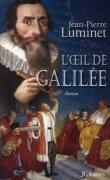L'Oeil de Galilée

October 1601. At the funeral of astronomer and mathematician Tycho Brahé, his successor, Johann Kepler grips the famous Euclid Cane that was bequeathed to him by Brahé. What everyone is unaware of is that the cane is hollow and that Kepler has hidden thousands of observations stolen from Tycho’s money hungry heirs inside. The English spy, Asquew, is very interested in getting a look at the information it contains as he is sure it will help her majesty Queen Elisabeth I’s ships navigate the world’s oceans. Kepler’s preoccupations are, however, purely scientific: he wants to determine the planets orbits, particularly Mars, without using mathematical artifice. The three laws of Kepler that will revolutionise our vision of the universe are about to be discovered. However, in Italy, Galileo has invented an astronomer’s lens and discovers the satellites of Jupiter. Kepler had previously attempted to correspond with him but to no avail. Galileo feared any contact with the protestant Kepler would put him in danger of the Vatican and the Inquisition. In Prague, at last in possession of the famous astronomer’s lens, Kepler can confirm the Italian’s discoveries.
Jean-Pierre Luminet (born 1951) is a French astrophysicist, specialized in black holes and cosmology. He works as research director for the CNRS (Centre national de la recherche scientifique), and is a member of the Laboratoire Univers et Théories (LUTH) of the observatory of Paris-Meudon. He also serves on the Astronomical Review Editorial Board.